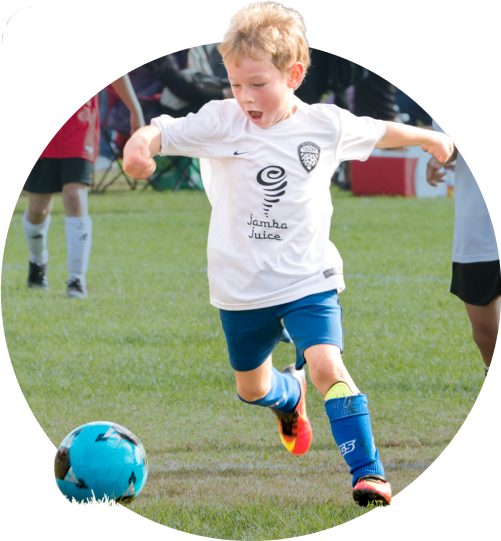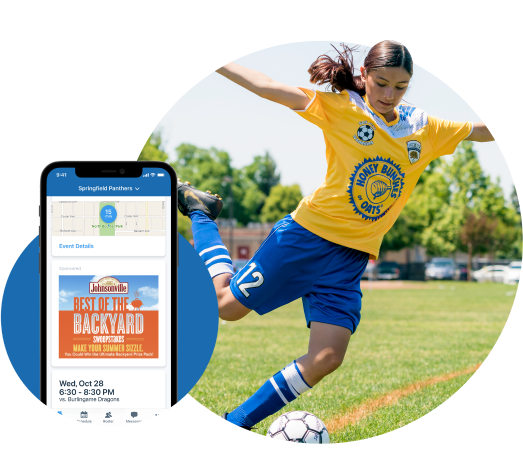Brand Awareness Marketing: What You Need to Know
Learn about brand awareness marketing, measurement, and strategy.


Brand Awareness Marketing With Youth Sports Sponsorships
TeamSnap empowers brands to create authentic relationships with families through youth sports sponsorships and digital media targeting families in the #1 youth sports coordination app. Unlike other marketing channels, we engage families when and where it matters most - at the field, at home, and on the go.
Learn how our partners including Dairy Queen, Gatorade, Johnsonville, Marriott, and Panda Express use TeamSnap to reach the Chief Household Officer.
Learn MoreBRAND AWARENESS MARKETING
It’s common for marketing teams to focus all their efforts on impacting the performance metrics found at the bottom of the marketing funnel — metrics like conversion rate or downloads that give you concrete numbers with which you can measure progress. However, to drive those kinds of metrics, companies need to consider the bigger picture. That’s why brand awareness is one of the most important elements of a successful marketing strategy, even though it’s a much broader, top-level metric. Brand awareness’s importance may be easy to overlook, but it’s the starting point for many of the positive outcomes marketers are often looking for lower in the funnel.
But what is brand awareness in marketing? Brand awareness is a simple concept that describes what happens when consumers are familiar with a brand and easily recognize its products, logos, slogans, or other distinguishing features. For example, brands like Apple and Nike have extremely strong brand awareness. Few people who saw the Apple logo or heard the phrase “just do it” would be unable to name the associated brand. Brand awareness marketing seeks to create this kind of effect for a business so that its identity becomes embedded in the general consciousness of its target demographic.
There are, of course, advantages and disadvantages of brand awareness campaigns. The advantages extend throughout many aspects of your business. Brand awareness helps build trust between your brand and consumers. When consumers are researching new products, they are often more likely to feel comfortable purchasing a product from a brand they have heard of before. Brand awareness can also improve sales numbers, of course. One of the most direct impacts of brand awareness campaigns is that they widen your pool of potential customers by increasing the number of people who know about your products.
On the other hand, one disadvantage of brand awareness marketing campaigns is that they are difficult to measure. It is not easy to define brand awareness in a quantifiable way. Some companies may choose to tie brand awareness to product sales, while others may measure it based on the brand’s number of social media followers. There are many different methods of measuring, and none of them are particularly definitive. However, despite the challenging nature of measuring brand awareness, investing in its improvement frequently leads to tangible positive impacts on other metrics.
BRAND AWARENESS STRATEGY
Brand awareness does not simply happen — it requires a carefully planned strategy, just like any other type of marketing campaign. An effective brand awareness marketing strategy has quite a few benefits. Here are some of the reasons why it’s beneficial to prioritize a strong brand awareness strategy:
BRAND AWARENESS IMPROVES CUSTOMER LOYALTY
One of the most important impacts of brand awareness is on customer loyalty. Improving brand awareness can help you build a larger, more devoted customer base. When consumers are considering which brands to buy products from, brand awareness plays a significant part in their decision. If they aren’t sure, they will often go with the brand they recognize. When consumers consistently receive quality products and experiences from a brand, they start to associate the brand with quality. After that, they’re more likely to purchase from that brand on brand awareness alone, without giving the decision much thought.
BRAND AWARENESS INCREASES MARKET SHARE
When a consumer chooses a brand they recognize, that means they’re also intentionally not choosing the brand they don’t recognize. If you can generate enough brand awareness, you can outsell competitors in your market and widen your company’s market share. There are plenty of brand awareness strategy examples that prove the viability of this approach.
BRAND AWARENESS EXPANDS YOUR COMPANY’S REACH
Brand awareness can also help you expand your company to reach new audiences altogether. For example, utilizing new marketing channels your marketing team has not tried before could expose your brand to a whole new audience. Increasing awareness in this way could generate opportunities for growth you hadn’t even considered before.
Clearly, brand awareness holds a lot of importance for companies. A successful brand awareness strategy can create tangible improvements down the line, like better sales numbers and more new leads. Now that we’ve covered the importance of brand awareness let’s explore how to increase awareness.
5 TACTICS FOR INCREASING BRAND AWARENESS
There are many different ways to increase brand awareness. Today, there are more channels than ever through which you can spread the word about your brand. Most people assume that digital marketing channels are now the best, or even only, means of generating brand awareness. However, this is not necessarily true. Instead of asking how to increase brand awareness through digital marketing or how to increase brand awareness on social media, marketing teams should consider all kinds of marketing opportunities. Here are 5 ways of increasing brand awareness to help you build a brand awareness strategy in 2022 that’s successful:
1. ESTABLISH AN IDENTITY
Consumers are naturally more attracted to brands that have some kind of personality than brands that come off as faceless corporations. Creating a cohesive identity for your brand is an important first step toward generating awareness. Consider everything from your brand’s visual aesthetic to the kinds of values your company culture prioritizes.
2. TELL A STORY
Telling a story about your brand is a great way to humanize it and make it resonate with consumers, and it’s the perfect opportunity to introduce your brand’s identity as well. Think about stories that elevate the message at the heart of your brand — for example, much of Nike’s advertising revolves around stories of people working hard to overcome adversity.
3. GIVE TO THE COMMUNITY
One way to build your brand awareness and reputation amongst your target audience is by getting involved in the local communities (https://leagueside.com/brand-community-involvement-to-achieve-marketing-goals/) you serve. Brands that are meaningfully involved in communities will have a lasting and positive impression in consumers’ minds. For example, your company could sponsor community sports leagues (https://leagueside.com/overview/) for youth or adults through an organization like LeagueSide.
4. SHARE VALUE (THAT ISN’T YOUR PRODUCT)
generate brand awareness. This could be as simple as maintaining a blog that shares industry insights or other useful resources. If your company provides highly-specialized products or services, offering some of that expertise through other channels besides your regular products is a great way to increase brand awareness.
5. ALIGN YOUR BRAND WITH A CAUSE
Another effective way to raise brand awareness is to associate your brand with a cause you believe in. Many companies do this by donating a percentage of their profits to a particular foundation or by partnering with a charitable organization and championing their cause. This can reinforce your brand’s identity as well as create a positive association in the minds of consumers.
BRAND AWARENESS CAMPAIGNS EXAMPLES
There are all kinds of brand awareness examples that demonstrate some of the tactics mentioned in the list above. Some of the most successful brand awareness campaign examples use strategies like community outreach to great effect, proving that companies can create brand awareness without relying entirely on digital channels. In fact, brand awareness ads of other kinds can be even more effective than digital ads in some situations.
Some of the best brand awareness campaign examples generate awareness using means other than digital advertising. Brand awareness ads examples like community sports league sponsorships are still an effective form of brand awareness marketing despite the increasing prevalence of digital marketing. There are many famous brand awareness campaigns that have a combination of both digital and non-digital forms of advertising to thank for their success.
TYPES OF BRAND AWARENESS
Brand awareness can be broken down into a few different specific types of brand awareness. Marketing teams focus on different types of awareness if they have different brand awareness objectives.
Here are the four main levels of brand awareness:
Brand recall – Brand recall is when a consumer can name a brand when asked to list brands in a certain product category.
Brand recognition – Brand recognition is when a consumer is able to identify the brand when they see a logo or slogan or when they’re able to describe the product after only hearing the brand name.
Top-of-mind brand awareness – Top-of-mind brand awareness is when consumers frequently name a brand first when they’re asked to list brands in a product category.
Brand dominance – Brand dominance is when consumers can only name a single brand when asked to list brands in a product category. Brands like Coke or Band-Aid that have become synonymous with the products they sell have achieved brand dominance.
Regardless of which kind of brand awareness your marketing team plans to prioritize, the importance of brand awareness remains the same.
HOW TO MEASURE BRAND AWARENESS
One of the most significant downsides of focusing marketing efforts on increasing brand awareness is that it’s not easy to figure out how to measure brand awareness.
Luckily, in the past few years brand awareness surveys (https://leagueside.com/brand-community-involvement-to-achieve-marketing-goals/) have become more accessible to marketers looking for better measurability and insights into their campaigns. By surveying your audience pre and post campaign, you will be able to start measuring the “unmeasurable” and learn how well your marketing is resonating with customers.
Generally, brand awareness is a less quantifiable metric that contributes strongly towards other metrics you can easily measure, such as conversion rate for digital campaigns you are running concurrently. One way to see the impact of investing in brand awareness, study the change in lower-funnel metrics after you’ve spent time improving it.
Hopefully, the answer to the question “why is brand awareness important” is now abundantly clear. Prioritizing brand awareness may not feel like the most immediately gratifying strategy, but over time, brand awareness gains compound and lead to tangible progress like more conversions and higher revenue.